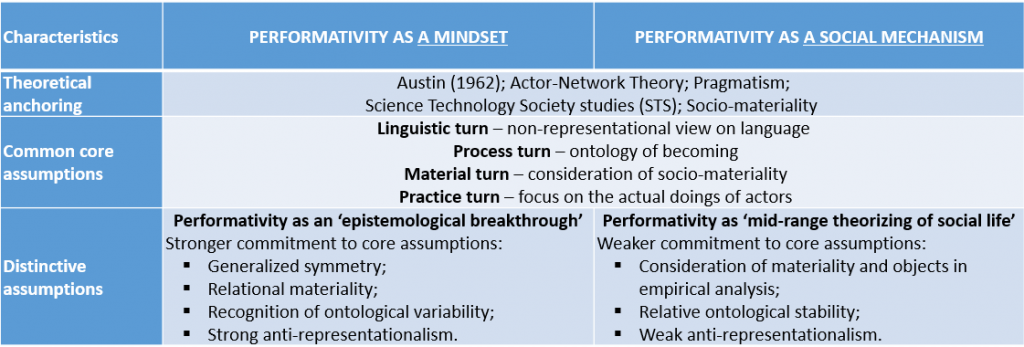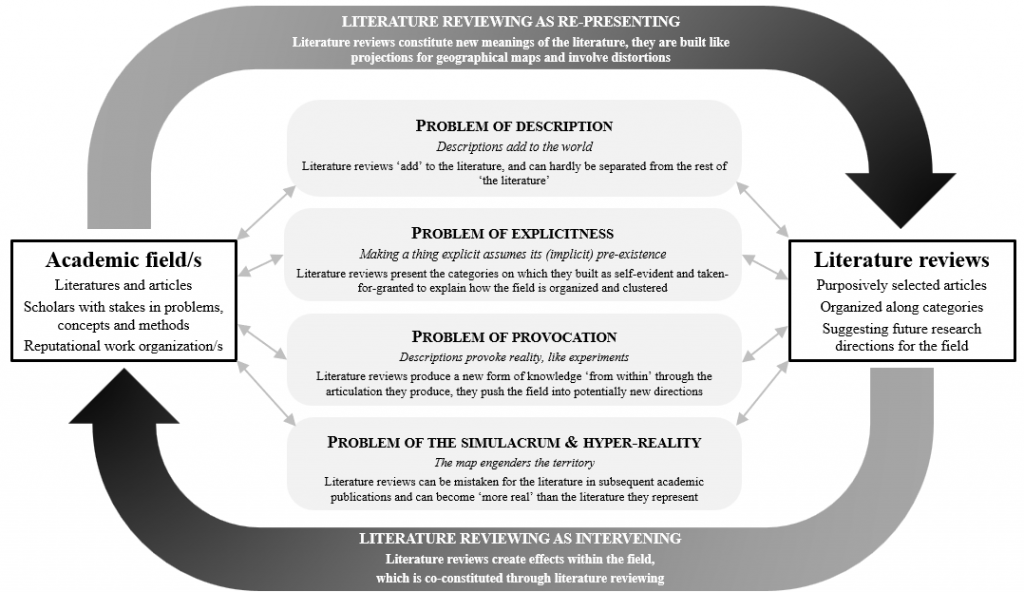Panel at the EGOS 2022 subtheme
On July 7, 2022, EGOS subtheme 6, “Performing Creativity, Innovation, and Change: Communicating to Reconfigure the Organization,” launched the CPO Standing Working Group. To initiate the conversation, François Cooren, Penny Dick, Jean-Pascal Gond and Consuelo Vásquez agreed to debate on the relationship between performativity research and communication scholarship in organization studies, CCO in particular. We offer here overviews of their presentations.
François Cooren: The performativity of classical conceptions of communication in organizations: How to offer alternative models that could be attractive to practitioners?
According to Gond, Cabantous, Harding and Learmonth (2016), four turns have influenced our conception of performativity:
- Discourse co-constitutes reality (discursive turn)
- Actual doing of organizational actors (practice turn)
- Organizational phenomena as fluid (process turn)
- Material effects of discursive practices (sociomateriality turn)
They also identify five conceptualizations of performativity can be identified:
- doing things with words (Austin)
- searching for efficiency (Lyotard);
- constituting the self (Butler, Derrida)
- bringing theory into being (Callon, MacKenzie)
- sociomateriality mattering (Barad)
For this intervention, I would like to focus on Callon’s, Latour’s and MacKenzie’s positions: scientific statements are not “outside the world(s) to which they refer,” but are “actively engaged in the constitution of the reality that they describe” (Callon, 2007, p. 318; see also Hacking, 1983). In other words, I am interested in how we bring theories into being. Callon and MacKenzie have explored the performative effects of economic theories, which has led to the idea of performation (Callon, 2007).
One possible path could be for us to study how ways to conceive and theorize communication are “actively engaged in the constitution of the organizational reality they are supposed to describe.” According to John Durham Peters (1999), we have two ways of conceiving communication: as dialogue or as dissemination. Practitioners tend to think communication as dissemination, while CCO scholars tend to think communication as dialogue. We must do some work to show practitioners that other theories of communication exist and that they can be useful, especially dialogical ones. The world of organization is a world of habits; how could we change this world?
Penny Dick: Gender inequalities, performativities and the generation of resistant discourses
Gender inequality research has long highlighted how women are often excluded from senior management roles due to them performing differently to men. Women tend to be more relational – concerned with interaction and supportive behaviours, whereas men tend to be more focused on the technical elements of roles. But more than this, is the fact that physical and visible presence is expected of senior management – to be available at all times and to ideally work full time with additional hours where necessary. Women may work part-time or work flexibly and their physical absence is often read as signifying a lack of commitment, engagement and ambition.
Working flexibly can therefore carry considerable stigma and research suggests that women engage in various behaviours to deal with this, particularly passing. All of this assumes, of course, that people who work full time are contributing more to their work than those who do not and there is evidence that this idea is increasingly being challenged. This is because the stigma that accompanies part-time working disrupts that individual’s sense of social value or worth and this is experienced as aversive.
Individuals are interrogating both what it means to make a contribution and whether this is something that is actually demonstrated via presence and visibility or they may subvert the idea that career success is synonymous with upward mobility and the need to be visible, arguing that success inheres in life and work not just work. This disruption of dominant tropes of “good management” and “career success” may carry the potential for organizational transformation but as yet we lack insights into when and where this might happen or what might prevent its occurrence.
Jean-Pascal Gond: Conceptualizing theory performativity as a mindset, a social mechanism and a reflexive method



Consuelo Vásquez: The performativity of silence: Reflections from Latin-American subaltern studies
Erik Torrico Villanueva (2016) notes that Latin America has produced a situated episteme in communication studies that stems from its subalternized position and is marked by processes of conquest, colonization and incomplete independence. The most common Latin Americanist response recognizes that the subaltern is a subject that can speak, yet the conditions of enunciation are that of silence. Mario Rufer (2012) illustrates this discursive condition with the words of Don Efrén, one of the participants in his field study, who ironically told him, “Don’t write that, because it won’t help you at the university… say that we are Indians and that we dress like them, and that we live on dirt floors” (p. 65). Silence is here a precondition of subalternity; an act of control and subordination, that Don Efrén is aware of. Maria Josefina Saldaña-Portillo (2003) similarly notes that the Zapatistas have reinscribed ‘Indian difference’ onto the revolutionary map through what she calls ‘noisy silence.’
CPO is an opportunity for us to explore the political figure of silence as resistance, (imposed) consent, control and secrecy. We can delve into another semiotic ordering, which is not centered in speech and language, but rather asks: what are the organizing/disorganizing properties of silence? It invites exploring the political figure of silence as resistance, (imposed) consent, control and secrecy. Researchers in CPO can interrogate the mechanism of translation and representation through which silence is rendered intelligible, thus recognize our privileged position as those with authority to speak on behalf of others. We also need to listen to silence, accept it, but also recognize the noisiness of silence, considering silence as disruption.

No responses yet